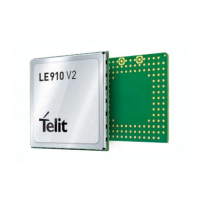Telit LE910 V2 Series AT Commands
80446ST10707A Rev. 0– 2015-11-03
Reproduction forbidden without Telit Communications S.p.A. written authorization - All Rights Reserved page 257 of 509
Mod. 0808 2011-07 Rev.2
Show Address - #CGPADDR
[<cid>[,<cid>
[,…]]]
Execution command returns either the IP address for the GSM context (if specified)
and/or a list of PDP addresses for the specified PDP context identifiers
Parameters:
<cid> - context identifier
0 - specifies the GSM context (see +GSMCONT).
1..5 - numeric parameter which specifies a particular PDP context definition (see
+CGDCONT command).
Note: if no <cid> is specified, the addresses for all defined contexts are returned.
Note: issuing the command with more than 6 parameters raises an error.
Note: the command returns only one row of information for every specified <cid>,
even if the same <cid> is present more than once.
The command returns a row of information for every specified <cid> whose
context has been already defined. No row is returned for a <cid> whose context has
not been defined yet. Response format is:
#CGPADDR: <cid>,<address>[<CR><LF>
#CGPADDR: <cid>,<address>[…]]
where:
<cid> - context identifier, as before
<address> - its meaning depends on the value of <cid>
a) if <cid> is the (only) GSM context identifier (<cid>=0) it is the
dynamic address assigned during the GSM context activation.
b) if <cid> is a PDP context identifier (<cid> in (1..5)) it is a string
that identifies the terminal in the address space applicable to the
PDP. The address may be static or dynamic. For a static address,
it will be the one set by the +CGDCONT command when the
context was defined. For a dynamic address it will be the one
assigned during the last PDP context activation that used the
context definition referred to by <cid>.
Note: if no address is available the empty string (“”) is represented as <address>.
Test command returns a list of defined <cid>s.
#SGACT: xxx.yyy.zzz.www
OK

